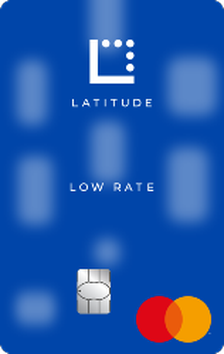What is a low interest credit card?
A low interest credit card is typically defined as one with a purchase rate below 15% p.a. While some credit cards in Australia offer rates starting from 0% p.a., those under 15% are generally marketed as ‘low rate’ options.
Compared to credit products (like home loans and car loans), these rates probably don’t seem particularly low. But credit cards generally have higher interest rates than other products.
In fact, credit card interest rates often exceed 20% p.a. Higher rates tend to apply to cards that offer more perks to customers, like rewards credit cards and frequent flyer credit cards.
A low interest credit card can be used in stores and online, with the lender providing funds (up to a limit) for transactions. You get a bill for the balance spent at the end of the month.
If you carry a balance, the lower interest rate helps reduce the cost of interest charges – especially useful if you’re only able to pay the minimum amount each month.

Pros and cons of a low interest credit card
Pros
- Lower interest on purchases helps reduce the cost of carrying a balance.
- Often come with low or no annual fees.
- Good option for budget-conscious or first-time cardholders.
- Some include basic perks like purchase protection or interest-free days.
Cons
- Fewer rewards or loyalty points compared to premium cards.
- May lack extras like travel insurance.
- Cash advances and balance transfers may attract higher rates.
- Lower credit limits are more common on these cards.
Choosing the best low rate credit card
The best credit card in Australia won’t always be the one with the lowest interest rate. In fact, a 0% interest credit card could actually work out more expensive than a card with a 20% interest rate. It all comes down to how some credit cards work, how you use the card, and the fees.
For example, some no-interest credit cards charge a monthly fee, with a higher fee for a higher credit limit. Some low rate credit cards charge a higher annual fee. On the other hand, a card with a high interest rate but no annual credit card fee might not cost you anything, as long as you pay off the card’s balance in full every month.
Low interest rate credit card perks to look out for
0% balance transfer
Means you won’t be stung any interest for moving all or part of your existing credit card balance to a new card.
Price protection
Refunds the difference if you find a lower price on an item you’ve purchased, within a specified period.
Purchase protection insurance
Covers items you’ve bought against damage, theft or loss for a certain period after purchase.
Smartphone screen insurance
Covers the cost of repairing or replacing your phone’s screen if it gets damaged, typically within a timeframe after purchase.
Extended warranty insurance
This extends the manufacturer’s warranty of eligible purchases, providing additional coverage for a specified period.
0% international credit card transaction fees
Means you won’t incur extra charges when making purchases overseas or in foreign currencies, saving you on conversion fees.
Interest free days
Even with a low rate, having a high number of interest free days means you have more time after your credit card statement period begins before interest kicks in. Up to 55 days is generally the max.
Complimentary travel insurance
Not as common as an inclusion with other credit cards, but it may come with travel insurance, covering domestic and/or international trips.
Expert’s top low interest credit card pick

Brad Kelly, Credit Card Expert
“There are still low interest rate credit card bargains to be had. The G&C Mutual Bank Visa is my favourite. 7.49% p.a. on purchases with up to 50 interest free days, a $50 annual fee, and you can start with a low limit of $1,000 (the max is $75,000). Just don’t use the card for cash advances as the interest rate jumps to more than double – 15.49% p.a.”
Brad Kelly, Credit Card Expert
How much does a low interest credit card cost?
The annual fees for low interest credit cards are typically lower than premium cards like gold, platinum or black cards.
You can expect to pay between $0 to $100 per year to use your card, with the average credit card fee on a low rate card currently sitting around $46.
Other fees that may come with your card (depending on how you use it) include:
- Foreign currency conversion fee
- Balance transfer fee
- Over limit fee
- Late payment fee
- Cash advance fee (e.g. for withdrawing cash)
- Dishonour of direct credit fee
- Replacement card fee
- Additional cardholder fee
What are the different types of credit card interest rate?
Purchase rate
This is the rate that most commonly applies, as it’s what’s charged to any in-store or online purchases and bill payments.
Cash advance rate
This is the rate (usually higher than the purchase rate) charged for withdrawing cash from an ATM, or making cash transfer from your credit card account.
Balance transfer rate
This is the special introductory interest rate offered on credit card balance transfers. This rate applies to the transferred balance only and for a limited time, after which the card’s cash advance rate usually kicks in.
Introductory rate
Some cards come with a special introductory offer rate. This rate can make certain cards appear to be cheap, low interest credit card options. But a higher interest rate inevitably comes into effect when the special rate lapses.
Top 3 uses for a low interest credit card
Balance transfers
Some people choose a low interest credit card in order to transfer the balance of an existing credit card to a new card offering a special no-interest period. Some cards offer 0% balance transfer up to a maximum of 28 months, which can save you on interest payments if you have a balance owing on your credit card.
Something to keep in mind with balance transfers is the balance transfer revert rate, which can be significantly higher than the standard purchase rate. The card will automatically revert to this higher rate when the intro offer period ends.
Minimising ongoing interest costs
For people who anticipate carrying a balance on their credit card from time to time, a low rate card may be an option. Instead of going for a rewards credit card offering perks, a low rate interest card will give the same access to credit, but with much lower interest costs.
For example, if you need to make a large one-off purchase, using your low rate credit card and paying it off over a few months will likely be more simpler than applying for a personal loan. However, it could work out very expensive if you only make the minimum payment each month. Even if you have a low interest card.
Access to certain perks
Low interest rate credit cards rarely come stacked with features, perks and points, but some do offer a level of rewards. This could include limited point-earning capacity, and insurance to cover the purchases you make using your card, or even credit card travel insurance.
If you're looking for perks without the interest, a charge card is another option. Charge cards do not incur interest but the balance must be paid off in full every month.
Eligibility requirements for a low rate credit card
To qualify for a low interest credit card you must meet the following qualifying criteria:
- Be over 18 years of age
- Be an Australian citizen or permanent resident
- Have a good credit rating
- Not be bankrupt
Before applying for a credit card it’s a good idea to check your credit score to make sure you’re in a good position to be approved.
Note, the eligibility criteria will be different for low-rate business credit cards and corporate credit cards.
How to apply for a low rate credit card
The first step toward getting a low interest credit card is completing an application form. You’ll be asked to provide proof that you earn enough income to pay back the credit based on your approved limit. This will include your:
- Income
- Employment details
- Assets and liabilities
- Expenses
Some credit card applications are approved almost instantly. After you submit your details, the card provider will give you a response within 60 seconds. Alternatively, the lender may ask for additional information before approving your application. Keep in mind that some credit cards are easier to get approved for than others (i.e. basic cards may have simpler eligibility requirements compared to premium options).
























